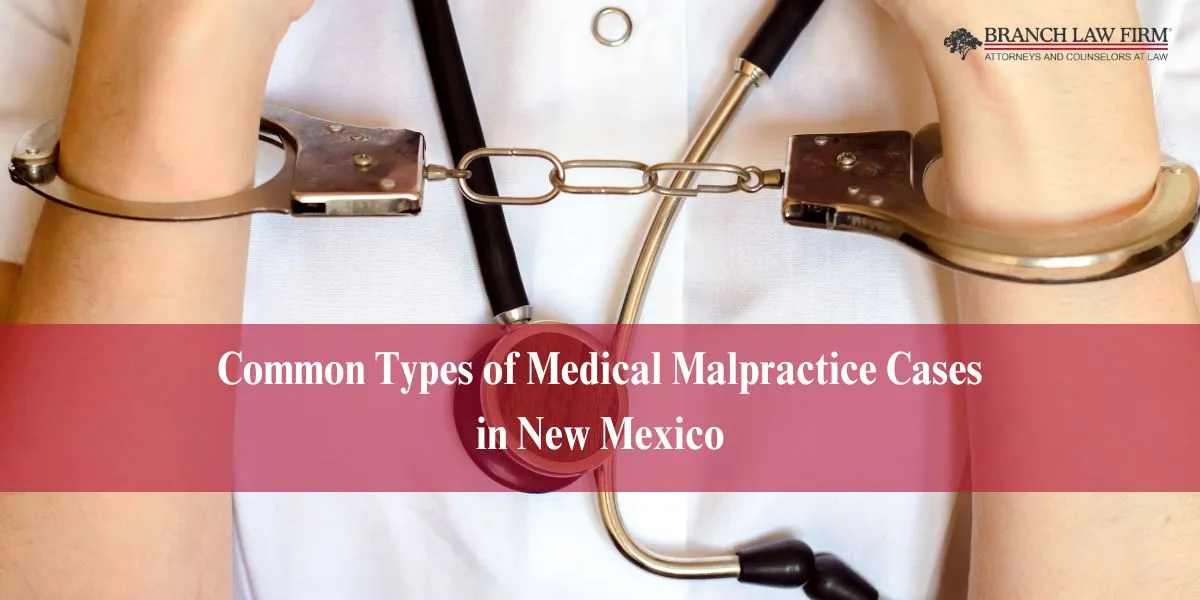You put your trust in many different medical professionals over the course of your lifetime. If you suffer harm at the hands of these individuals and their negligence, it can be a devastating blow, both physically and mentally. Unfortunately, these cases occur time and again in the state of New Mexico. There are several common types of medical malpractice cases in New Mexico.
If you have been a victim of medical malpractice, know that there are options available to you. The reality is that medical malpractice has the ability to change people’s lives permanently. However, many victims don’t seek compensation or file a claim. Some individuals may be uncertain of what exactly happened in their case or if it even counted as medical malpractice.
What Is Medical Malpractice?
In general terms, medical malpractice occurs when medical care does not meet the accepted, professional standard of care. No matter their role in the healthcare community, any medical professional can be held accountable for their actions if it can be proven they had a certain duty of care to their patient and failed to perform that duty, resulting in damage to the patient.
Medical malpractice can occur in hospitals, clinics, private practices, and other such settings of medical care. In a recent study put out by Johns Hopkins Hospital, medical malpractice is the third leading cause of death in the United States. It is estimated that 250,000 deaths are a result of medical errors annually.

Common Causes of Medical Malpractice in New Mexico
The healthcare system has a complex and extremely nuanced nature. Something that might be true for one patient might not be true for another, even if they are suffering from similar symptoms. Medical errors can occur in almost every branch of the healthcare system, including surgeries, birthing events, and laboratory testing.
While it’s true that each case is different, there are common occurrences across the board that can result in medical malpractice.
- Errors in Diagnosis: The most common cause of medical malpractice, misdiagnosis can result in patients not receiving the necessary treatments that can lead to healing and prolonged life. Your doctor may even overlook symptoms or treat you for the wrong ailment, which can lead to harmful side effects, injury, and even death.
- A Failure to Treat: After a diagnosis, the patient’s care will come in the form of treatment. If there is a lapse in treatment, additional health issues may arise. A failure to treat can happen when a medical professional incorrectly evaluates symptoms, fails to perform correct tests, or fails to make proper referrals for further treatment.
- Mistakes in Surgery: Surgical mistakes don’t just happen in the operating room. They can occur pre- or post-operation. Common mistakes in surgery can include punctured tissues or organs, a failure to remove all surgical aids from the body, operating on the wrong part of the body, operating on the incorrect patient, or even choosing to perform surgery without exploring other options first.
- Medication Errors: Medication is meant to help a patient, but in some cases, it can cause more harm than good. When medication is improperly given, it can result in devastating damage. Common errors include a failure to gather all of the patient’s medical history, including medication allergies, failing to heed potential interactions with other drugs, dosage errors, or mistakes made by the pharmacy when filling a script.
- Injuries in Childbirth: Childbirth is often an exciting time for a family, but, like any other medical event, it carries the chance for medical malpractice to occur. It can occur due to the lack of necessary prenatal care, errors in medications, a failure to diagnose a condition in the mother, a failure or delay in ordering a life-saving C-section, or injury from certain birthing tools.
- Infections: Many medical settings can be a breeding ground for countless infections. Patients are more susceptible to these infections when medical providers do not do what is necessary to protect their patients. Common infections that lead to medical malpractice cases include Staphylococcus aureus, or “staph infections,” urinary tract infections, pneumonia, and infections of the surgical site.
- Defective Medical Equipment: Even the simplest of medical procedures can include various pieces of medical equipment. If even just one malfunctions, it can lead to injury or even death for the affected patient. These equipment malfunctions can involve heart monitors, defibrillators, or breathing-assistance machines.
FAQs
What Is the Most Common Type of Medical Malpractice?
In the state of New Mexico, the most common type of medical malpractice is the misdiagnosis or delayed diagnosis of a patient’s ailment. When healthcare providers fail in their duty to adequately diagnose a patient correctly and in a timely manner, this can lead to further health conditions or a worsening of the condition one is already suffering.
What Is the Most Common Reason for Medical Malpractice?
The most common reason for medical malpractice is negligence. Most healthcare professionals do not look for ways to cause medical malpractice. However, that doesn’t mean it doesn’t happen. Negligence is when a medical professional fails in their duty of care.
What Is the Hardest Element to Prove in a Medical Malpractice Case?
In medical malpractice cases, the hardest element to prove is causation. It can prove difficult to establish that the injury or illness suffered by the patient would not have occurred if the medical healthcare provider had acted differently, as well as that their actions constituted negligence.
Why Are Medical Malpractice Suits Hard to Win?
Medical malpractice suits can be difficult to win for a litany of reasons. First, there must be a scientific basis to support the claim. It is also expensive to pursue certain claims, especially if expert witnesses need to be brought in to give testimony. It can be difficult to demonstrate that the patient’s injury or illness was a direct result of the healthcare provider’s negligence rather than an underlying injury or illness.
Contact a Trusted Medical Malpractice Lawyer Today
If you or someone you love has suffered at the hands of medical malpractice, it’s time to take action. Contact the team at the Branch Law Firm today to discuss your case and let us help you understand your rights. These cases are rarely simple to prove, and it is crucial to have a skilled medical malpractice lawyer on your side who can look over the nuances of your case and fight for the justice and compensation you deserve. Connect with us today.
 Knowledge Experience Compassion Service
Knowledge Experience Compassion Service 






